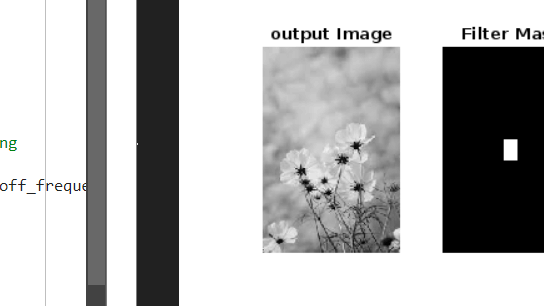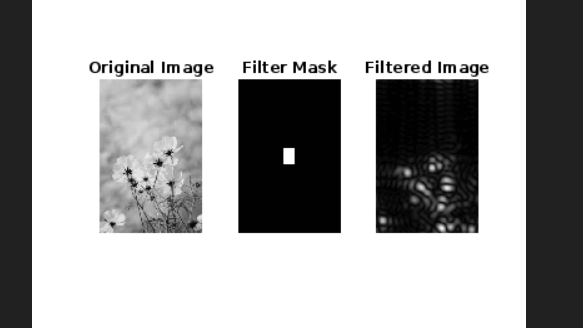MATLAB - Ideal Highpass Filter in Image ProcessingThe principle of an optimal highpass filter is applied to image processing to boost high-frequency elements while suppressing low-frequency ones. It's crucial to remember, though, that the qualities of an ideal highpass filter make it theoretical and impractical. Other highpass filter types with finite cutoff frequencies are utilized in practice because they are easier to implement. Steps:Your method is a well-organized breakdown of the processes needed to use MATLAB to create an optimum highpass filter for image processing. Permit me to talk briefly about each step: Step 1 The first step is input, which involves reading a picture. It's crucial to pick the right image to bring out the highpass filter's effects. Step 2: It's a good idea to save the size of the input image because it will be useful for further calculations and operations. Step 3: The Fourier Transform of the input Step 4: It's crucial to assign the Cutoff Frequency D0. Which frequency components are regarded as "high" frequencies are determined by this parameter. The results of the filtering will change if this value is changed. Step 5: The mask for the frequency domain image is created while designing the filter. This is a binary mask with 1 for high frequencies and 0 for low frequencies in the case of a perfect highpass filter. Step 6: Convolution of the Fourier transforms in The filtering mask and the transformed input image are a frequency-domain multiplication of elements. Low-frequency components are suppressed while the high-frequency components are emphasized. Step 7: Taking the Inverse Fourier at The image is transformed to restore the spatial domain while maintaining the high-frequency accent. Step 8: The last step is to display the completed image, step eight. This lets you visually compare the image and the filtered output and see how the highpass filter has affected the image. Note: Your method offers an easy-to-follow, logical process for creating the optimum highpass filter in MATLAB. To comprehend the optimum highpass filter, remember that it has limits in real-world applications because of its abrupt cutoff and ringing distortions. Other filters like Gaussian or Butterworth highpass filters are frequently preferred for practical applications.Implementation:output: 
The IHPF algorithm is implemented step-by-step in this code using MATLAB. It takes in an input image, filters it in the frequency domain, and outputs sharpened images for display. [Name of input image file] can be changed. Put [file format] in place of your input image's real filename and file format.
Output: 
Benefits and Limitations of Highpass: filterEven though the ideal highpass filter is rarely employed in actual image processing because of its idealized characteristics and related artifacts, knowing its advantages and disadvantages might help us comprehend more practical filtering methods. Benefits of considering the optimum highpass filter in image processing: Simple implementation and conceptual understanding make The ideal highpass filter an effective educational tool for introducing the ideas of frequency domain filtering and Fourier transformations in image processing. Understood theoretically: The impact of high-frequency components in images can be understood theoretically using the ideal highpass filter as a point of comparison. It draws attention to how different frequency ranges affect certain aspects of an image. Visualization of Artifacts: Although ringing and noise amplification artifacts are known to be produced by the ideal highpass filter, they can be used to illustrate the difficulties in quickly deleting low-frequency information.
Finding Edge Information: The optimal highpass filter highlights edges and distinct transitions in the image, making it beneficial for emphasizing characteristics and structures crucial in particular applications, such as edge identification. Artistic Effects: The artifacts produced by the perfect highpass filter can be used in creative applications to develop artistic effects, giving images a distinctive texture or stylized appearance.
Exploration of Limitations: The shortcomings of the ideal highpass filter highlight the difficulties in practical image processing, leading to the development of more complex filters that address problems like ringing artifacts and noise amplification.
The perfect highpass filter has several severe drawbacks when it comes to actual image processing despite having some theoretical characteristics that may appear appealing: Ringing Artifacts: The ideal highpass filter's frequency response has a sharp transition, which causes ringing artifacts in the spatial domain.
Aliasing: The ideal highpass filter must consider the idea of aliasing, which happens when high-frequency data collapses back into lower frequencies due to undersampling. Sensitivity to Noise: The optimum highpass filter enhances edges and high-frequency noise. As a result, noise in the filtered image may be amplified, making it less appropriate for real-world noisy photos. Loss of Low-Frequency Information: A good highpass filter strips the image of all low-frequency elements. Important nuances and textures in the low-frequency region may need to be recovered. Unrealistic Assumptions: The ideal highpass filter erroneously assumes that it is possible to accomplish sudden changes in the frequency domain without effects on the spatial domain.
Unnatural Appearance: The filtered image may appear too crisp and unnatural due to the amplification of high-frequency components. This can produce an unpleasant visual result. Implementation Challenges: The optimal highpass filter necessitates complex mathematical processes that are challenging to execute in real life. The usage of infinite values is required due to the sudden shift in the frequency domain, which cannot be directly realized in discrete systems. |
 For Videos Join Our Youtube Channel: Join Now
For Videos Join Our Youtube Channel: Join Now
Feedback
- Send your Feedback to [email protected]
Help Others, Please Share









